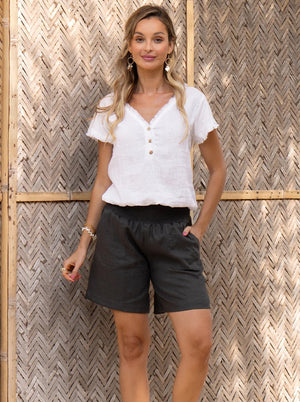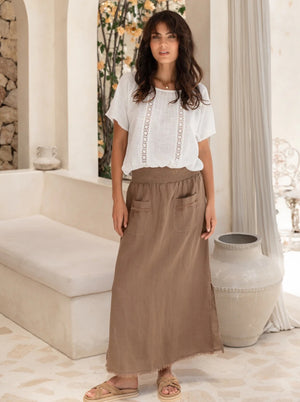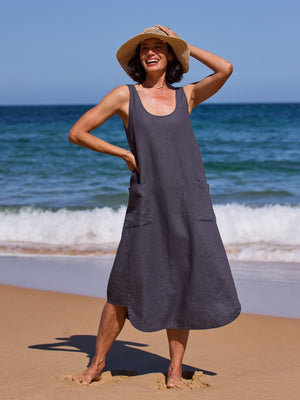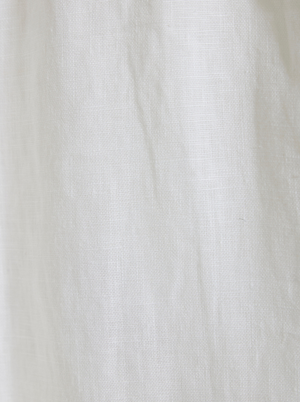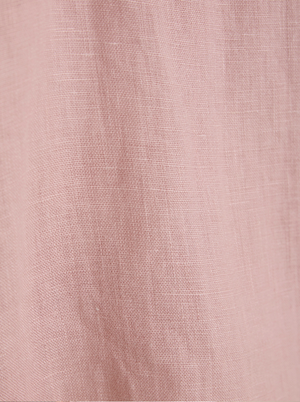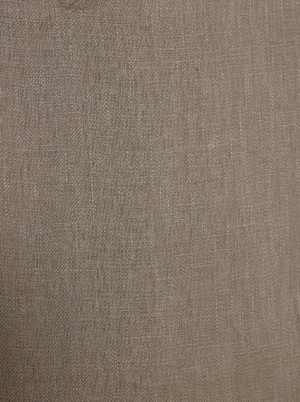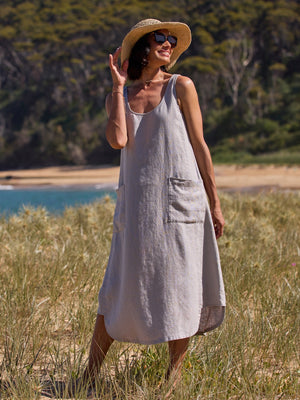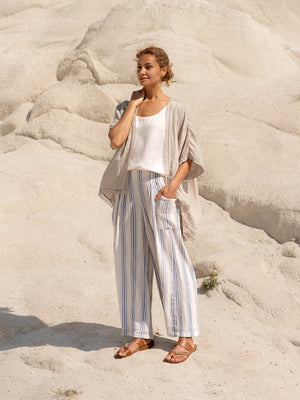The Art of Handloom Fabrics: Unraveling Indonesia's Textile Heritage

“If you’re like me (or live in Melbourne), there’s nothing better than a scarf, a shawl, or a shrug. The Bloom Cotton Shrug in Ecru is one of the best. The cotton weave makes it perfect for all seasons: not too heavy, not too light, just right."
This glowing testament highlights the allure of the Bloom Cotton Shrug Ecru. Made by skilled artisans in Indonesia from 100% textured woven raw cotton, it’s a prime example of the unique beauty of handloom fabrics and the essence of ethically crafted fashion.
In this blog, together we’ll explore the world of hand-crafted textiles and celebrate fabrics that tell stories. It’s for those who see their clothes as more than just garments. It’s about the tradition, the people, and the care behind every piece.
Let’s dive in.
What are Handloom Fabrics?
Handloom fabrics, or as we often call them, “handwoven” fabrics, are textiles woven on a hand-operated, non-mechanized loom.

The beauty of handloom lies in the process — a dance of the warp and the weft. The warp threads run vertically, setting the backbone of the fabric, while the weft threads weave in and out, creating patterns and textures unique to each piece.
This traditional method of fabric-making allows for a level of detail and a personal touch that machine-made fabrics simply can’t replicate.
How Handloom Fabrics are Made
Imagine the handloom as an artist’s canvas, where threads are the medium through which intricate designs come to life.
The process begins with setting up the warp, the set of lengthwise threads held in tension on the loom. This task requires precision, as the arrangement of the warp determines the outcome of the weave.

Next comes the weft, the thread woven back and forth across the warp. Through a rhythmic dance of the shuttle carrying the weft, artisans weave their magic, intertwining the weft with the warp to create fabric. Once the fabric comes to life under the artisans’ hands, it’s transformed into garments, in our case, the Bloom Cotton Shrug.
Unlike modern methods that rely on synthetic materials like nylon and polyester, traditional weaving predominantly uses natural fibres like tree bark. While an industrial fabric might be produced in a few hours or days, hand-crafted items can take several days or even a month to complete, depending on the complexity of the design.
So when you buy a handwoven item, you’re not just getting a piece of clothing. You’re getting a piece of history, craftsmanship, and a lot of love.
What is Special About Handloom Fabrics?
Let’s unwrap the magic woven into every thread of handloom fabrics.
1. Uniqueness
Every handloom fabric is a piece of art. In Indonesia, where the craft has been passed down through generations, the uniqueness of each fabric is astounding. No two pieces are exactly the same because human hands, not machines, make them.
2. Quality
Imagine someone meticulously weaving cloth on a loom, using their hands and simple tools to interlace threads into fabric. Unlike machines that work at breakneck speeds, this process allows the weaver to pay close attention to the details, ensuring every thread is perfectly placed.

3. Comfort
Beyond their aesthetic appeal, handloom fabrics are a synonym for comfort. Natural fibres like cotton are commonly used, offering breathability and a gentle touch against the skin. These materials, combined with the skilled hands of artisans, create fabrics that are not only beautiful but also incredibly comfortable to wear in any climate.
4. Eco Friendly
Handloom fabrics are made using traditional methods that have been around for centuries.
Picture skilled artisans sitting at a handloom, weaving threads into cloth without using any electricity. This process has a low carbon footprint compared to modern machines that consume a lot of energy. Also, handloom weaving generally requires less water than the industrial process used to make fabrics.
Another sweet point is that handloom fabrics often use natural fibres, so they snuggle back into the earth more easily and quickly. Meanwhile, synthetic materials made from petroleum can take hundreds of years to decompose.
5. Important Source of Livelihood
Handloom weaving is more than just a craft; it’s a vital source of livelihood for many communities in Indonesia. It supports local economies, empowers women, and sustains traditional skills that might otherwise be lost. By choosing handloom, you’re not just buying a piece of fabric but helping preserve a way of life.

The History of Handloom Textiles in Indonesia
In Indonesia, the art of creating handloom textiles is more than a profession — it’s a tradition that’s lovingly passed from generation to generation.
Picture this: small, cozy workshops or the corners of family homes filled with the clack-clack of looms as artisans spin and weave magic with their hands. This industry thrives in intimate, cottage-style production settings, where each piece of fabric tells a story of dedication, skill, and community.
The heart of Indonesia’s handloom textile world beats strongest in regions known for their breathtaking and unique creations. From the intricate batik textiles of Central Java, with their complex patterns and vibrant colours, to the mesmerizing ikat textiles of East Java, each piece is a testament to the local culture and artisanal prowess. Bali and Sumatra are also critical players in this rich tapestry, each adding unique threads to the country’s textile legacy.
At Nomad the Label, we’re passionate about celebrating and sustaining these traditional crafts. That’s why we’ve chosen to work hand-in-hand with village co-operatives, small family businesses, and incredibly talented local designers. Our approach ensures that handloom textiles' exquisite artistry is preserved and thrives. Through partnerships with these communities, we can bring together the incredible work of numerous artisans.
And that brings us to our Bloom Cotton Shrug Ecru, a piece that embodies the beauty and craftsmanship of Central Java. Crafted by a skilled artisan in the heart of this region, this shrug isn’t just an article of clothing; it’s a piece of Indonesia’s rich textile narrative.

How to Tell If a Piece of Clothing Is Made from Handloom Fabrics
If you’re looking for an authentic handloom, it might be challenging to differentiate between the real and the fake.
But here are some tips for the next time you go handloom shopping.
Look at the texture and feel the fabrics: Handloom fabrics are often unique. They feel more natural and less uniform than machine-made fabrics. You might notice slight irregularities or variations in the weave. These are not flaws but rather signs of the human touch involved in its creation.
Price and source: Handloom fabrics often cost more due to the intensive labour and skill required to make them.
Feel the weight: Handloom fabrics can feel heavier or more substantial than their machine-made equivalents due to the denser weaving and the type of yarn used. This isn’t a rule but rather a general observation that might help in some cases.
How to Care for Handloom Fabrics
Taking care of handloom fabrics can make these beautiful items last longer and retain their unique charm. Some tips on how to do just that:
Wash gently: Handloom fabrics are best washed by hand with a mild detergent. If you must use a washing machine, opt for a gentle cycle and protect the fabric with a mesh laundry bag. Cold water is your best friend to prevent shrinking and colour bleeding.
Avoid harsh chemicals: Bleach and strong detergents can be harsh on handloom fabrics, stripping them of their colours and weakening the fibres. Stick to gentle, eco-friendly detergents, and always test a small, inconspicuous area first if you’re unsure.
Dry with care: Avoid wringing out handloom clothes after washing. Instead, gently squeeze out the excess water. Spread them flat on a clean towel from direct sunlight to air dry. This prevents the colours from fading and the fabric from losing its shape.
Iron on low heat: Iron handloom fabrics at a low-temperature setting while slightly damp. To protect the fabric, use a pressing cloth between the iron and the fabric. This will help remove wrinkles without damaging the fabric.
Store properly: Store your handloom garments in a cool, dry place. Avoid hanging them for long periods, as this can cause the fabric to stretch. Folding them with layers of acid-free tissue paper can help maintain their shape and protect them from dust.
Deal with stains immediately: If your handloom fabric gets stained, address it as soon as possible. Gently blot the stain, but don’t rub it, as this can make it worse. Use a mild detergent and water for washing, but for stubborn stains, consider taking it to a professional cleaner who knows how to handle delicate fabrics.
Refresh Your Wardrobe With Handloom Clothing
Indonesian handloom fabrics are more than just textiles; they’re stories of heritage and artistry.
Eager to carry a piece of Indonesian culture with you? Check out the Bloom Cotton Shrug Ecru on our site. Whether dressing up for a special occasion or adding a touch of elegance to your daily wear, it’s your perfect choice. Head to our shop to explore this exquisite piece and more from our collection.















